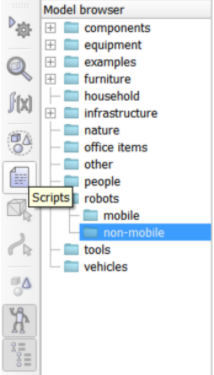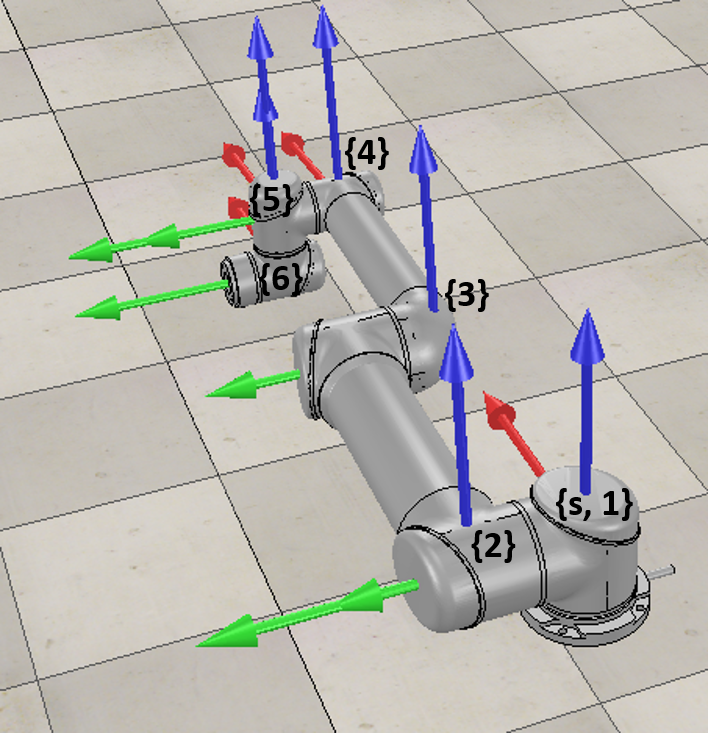ME 449 Assignment 1
Introduction
In the next chapter, we will study the forward kinematics problem for open-chain robots: finding the configuration of the robot's end-effector given the vector of joint positions . The forward kinematics problem is easy to solve using a formula called the "product of exponentials," which uses the matrix exponential of this chapter. In this project, CoppeliaSim will solve the forward kinematics for you.
The goal of this project is to test your understanding of the matrix log for rotations, to give you a little practice using the MR library of functions, and to familiarize you with CoppeliaSim.
You will submit a single pdf file to Canvas. The file name should be FamilyName_GivenName_asst1.pdf (for me, it would be Lynch_Kevin_asst1.pdf). You will have to concatenate all your responses into a single pdf file.
All assignments will be graded based on correctness, how clearly you organize your homework (the grader should easily find all of your solutions), and how well you follow the instructions. You will lose points if you don't follow the instructions or if the assignment is difficult for the grader to grade.
Part 1: CoppeliaSim Simulation and Exploration
Open Scene 1 for interactive manipulation of the Universal Robots UR5 robot, a popular 6R robot. (You can go to the CoppeliaSim Introduction to download Scene 1, or this page for a refresher on getting started with CoppeliaSim.)
When you run this scene you will see a window with two tabs: "Enter Config and SE(3) Value" and "Joint Angle Sliders". Go to the "Joint Angle Sliders" tab, move the sliders corresponding to the six joints, and watch how the robot moves. Also try using the controls at the top of the window to zoom the camera in and out, pan the camera, etc.
A CoppeliaSim scene may include objects (like shapes, joints, or sensors) and one or more models. A model consists of a number of objects connected to each other. In this scene, for example, there is a model of a UR5 robot, which consists of a collection of joints connecting shapes (links), from the base out to the end-effector.
A scene also includes a main script, which handles the simulation loop. At each simulation step, the main script calls (a) "actuation" functions that simulate the motion of the system and (b) "sensing" functions that simulate the sensors. Generally this main script should not be edited.
A scene also may include one or more child scripts. A child script can be threaded (which creates a new computation thread; this is generally discouraged) or non-threaded. A non-threaded script defines the "actuation" and "sensing" functions for an object or model, and these functions are invoked by the main script at each simulation step. More information can be found at Coppelia's webpage on main and child scripts, the CoppeliaSim User Manual, and the CoppeliaSim forum.
Make sure your scene 1 simulation is stopped so you can open up a script. Click the "Scripts" button on the toolbar on the left side of the screen (shown below) to see the scripts being run by the scene.
Double-click the "Non-threaded child script (UI_Script)" to open it. You will see a script written in the Lua programming language. Early in the file, you might notice that some functions look similar to functions written in the Modern Robotics Library. For example, so3andp2se3(R,p) in this script resembles RpToTrans(R,p) in the Modern Robotics Library.
Scroll down to line 242. From here to the end of the file, this code examines the type of "call" to the child script by the main script and performs the appropriate functions. For example, if the sim_call_type is sim.syscb_init, the simulation has started and the user interface should be generated. (There is a lot of XML code here defining the user interface.) If the sim_call_type is sim.syscb_actuation, then the joint angles entered by the user in the UI are applied to the UR5 model, the UI is updated, and the transformation matrix for the end-effector is calculated. If the sim_call_type is sim.syscb_sensing, nothing happens, and if it is sim.syscb_cleanup, the UI is destroyed as the simulation ends.
The XML code for the UI starts on line 251. This XML code controls the appearance of the Custom UI, including the layout and content of text boxes, sliders, tab titles, and font size. The XML syntax can be found at Custom UI Plugin XML Syntax. For this specific scene, the different text boxes and sliders are arranged in different groups. Each group has a layout which determines how the objects inside the group will be displayed and label text which determines what text will be displayed and how it will be displayed. If you'd like, you can consult the XML syntax for the attributes each element can have.
Your task: Modify the non-threaded child script (UI_Script) to change an aspect of the scene. For example, you can choose to change the Custom UI layout, change the titles and words of the Custom UI, or change font sizes in the Custom UI. Some example changes include:
- Changing the layout: consult the XML syntax and change <group layout="vbox"> to another type (hbox,form, grid, none). Using line 257, changing <group layout="vbox"> to <group layout="hbox"> changes the orientation of the items in the group containing "Configuration Entry", "Current configuration", and "Messages" on the "Enter Config and SE(3) Value" tab of the Custom UI from vertically arranged to horizontal.
- Changing the words: Find the text you want to change in the XML code. The text will be surrounded by quotation marks and have <big> and </big> on its sides. For example, line 258 "label text="<big> Configuration Entry:</big>" controls the text "Configuration Entry" on the "Enter Config and SE(3) Value" tab of the Custom UI. Change the words "Configuration Entry" to change the text displayed in that specific section.
- Changing the font: Using line 258 label text="<big>Configuration Entry:</big>"
- The font can be changed to small using: label text="<small>Configuration Entry:</small>"
- The font can be changed to a specific size using: label text="<font size=20>Configuration Entry:</font>", where 20 is the desired font size.
Part 2: Joint Angle Calculations
The 6R UR5 robot is shown below at its home configuration. Eight frames are defined: the fixed frame {s} at the base, frames {1} through {6} attached to links 1 through 6, and the end-effector frame {b} which is fixed relative to link 6. (The frame {b} is not shown in the image.) The red arrow is the x-axis, the green arrow is the y-axis, and the blue arrow is the z-axis. Frames {s} and {1}-{6} are aligned when the robot is at its home configuration, i.e., each rotation matrix (where could be or any number 1 through 6) is the identity matrix.
The rotation axes for joint , defined in frame {}, are .
For some set of joint angles , we have the following relations between the orientations of the joint frames:
- R13 = [[0, 0, -1]; [0, 1, 0]; [1, 0, 0]]
- Rs2 = [[0, -1, 0]; [-0.5, 0, -0.866]; [0.866, 0, -0.5]]
- R15 = [[-0.3536, -0.3536, 0.866]; [-0.7071, 0.7071, 0]; [-0.6124, -0.6124, -0.5]]
- R12 = [[-0.5, 0, -0.866]; [0, 1, 0]; [0.866, 0, -0.5]]
- R34 = [[-0.866, 0, -0.5]; [0, 1, 0]; [0.5, 0, -0.866]]
- Rs6 = [[-0.3536, -0.7071, 0.6124]; [-0.5732, -0.3536, -0.7392]; [0.7392, -0.6124, -0.2803]]
- R6b = [[-1, 0, 0]; [0, 0, 1]; [0, 1, 0]]
where {b} is the end-effector frame not shown in the figure.
Your task:
- Find the six-vector of joint angles given the above. (You will likely want to calculate the rotation matrices and use the MR code library, e.g., MatrixLog3.)
- Enter the joint angles you found into Scene1_UR5 in CoppeliaSim to see the configuration of the robot.
- Calculate Rsb using the information given, and verify that your joint angle vector is correct by entering the joint angles into the scene and comparing your Rsb to the rotation matrix portion of the Tsb calculated by the scene under the "Enter Config and SE(3) Value" tab.
What to turn in to Canvas: A single pdf file. The file name should be FamilyName_GivenName_asst1.pdf (for me, it would be Lynch_Kevin_asst1.pdf). This file should have:
- The list of the six joint angles you calculated, and a brief explanation of the method (including the MR code) you used to calculate them.
- A screenshot of the scene, clearly showing the modified UI, the SE(3) calculation, and the robot at the correct configuration.
- A screenshot of your changed code in the child script.
If you do not know how to take a screenshot, you can use one of the following:
- Mac: Cmd-Shift-3 and look for the screenshot on your desktop.
- Windows: Use the PrtScn button (or Windows Key + PrtScn or Alt _ PrtScn, etc.). You can also search for the Snipping Tool.
- Linux: you can use Screenshot or PrtScrn.









